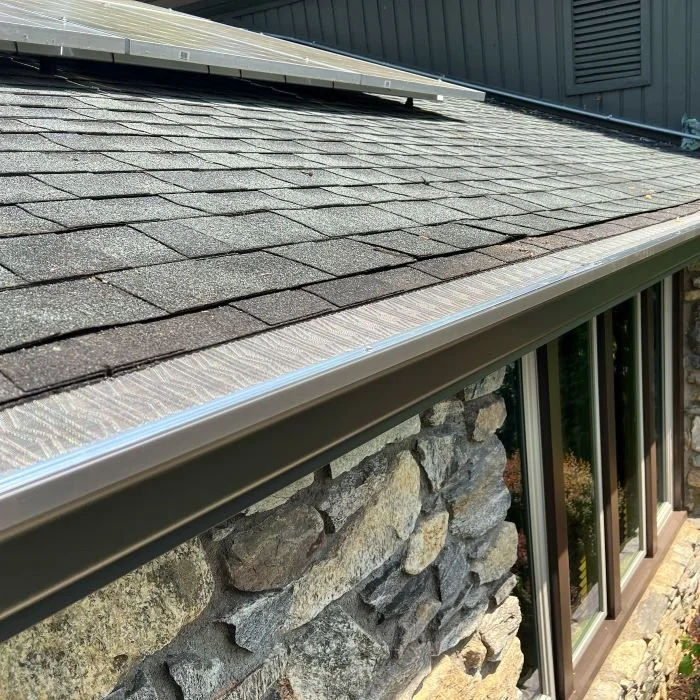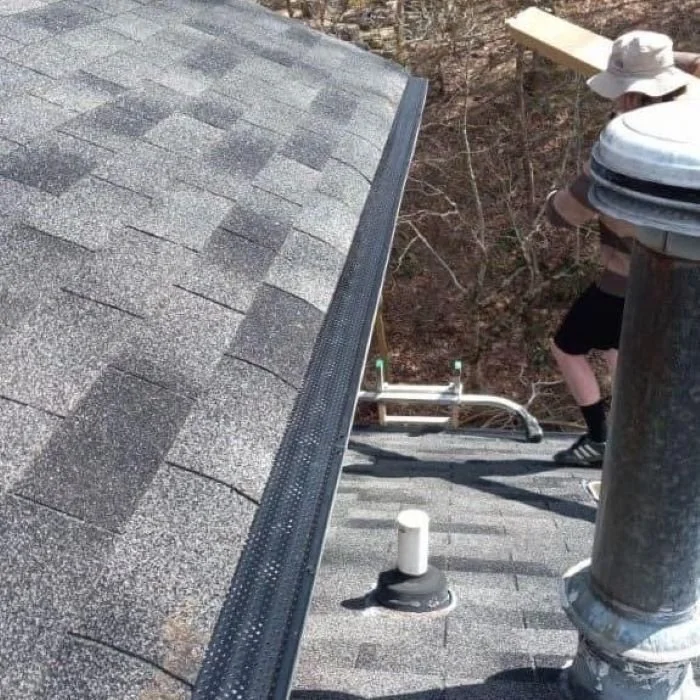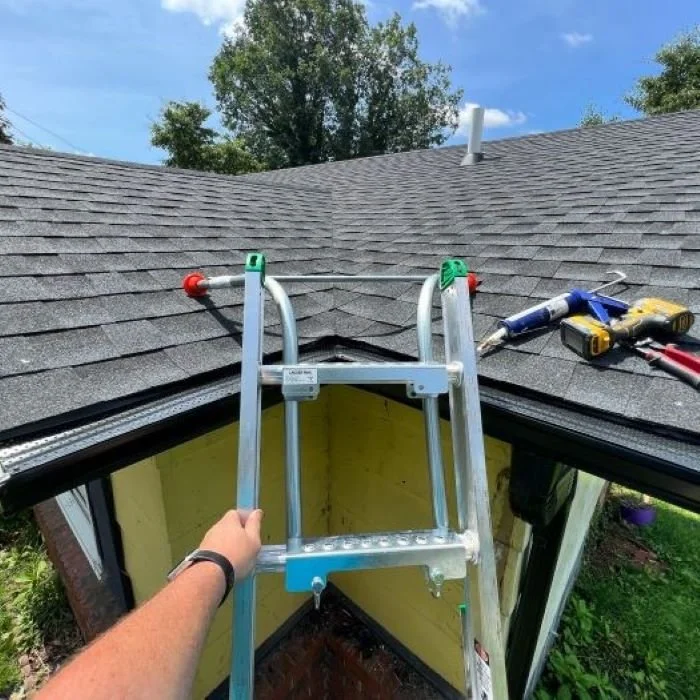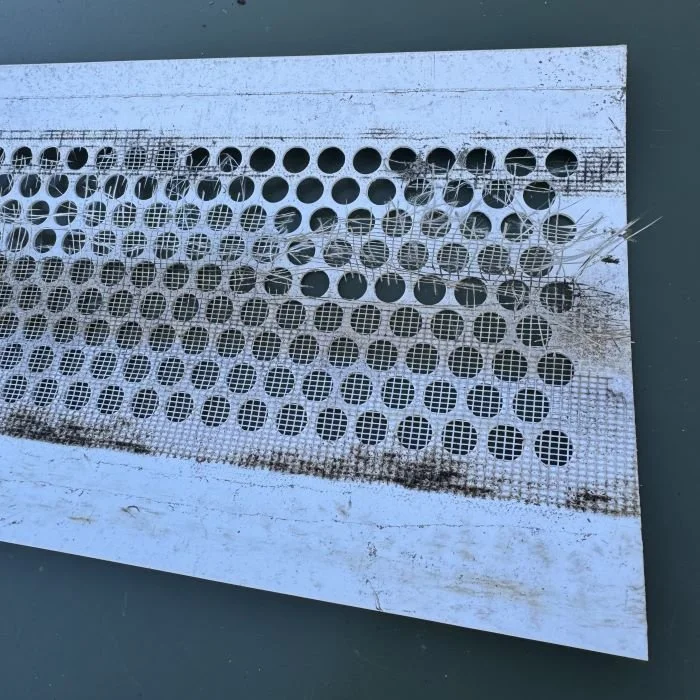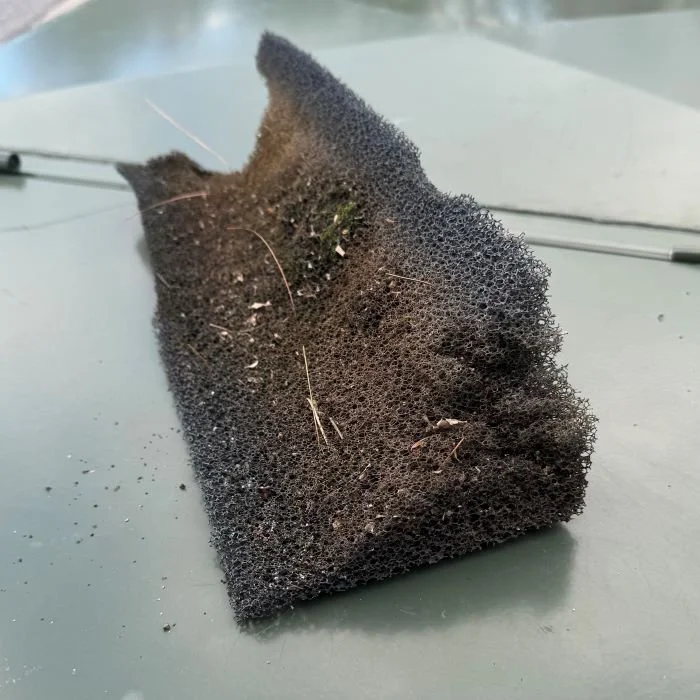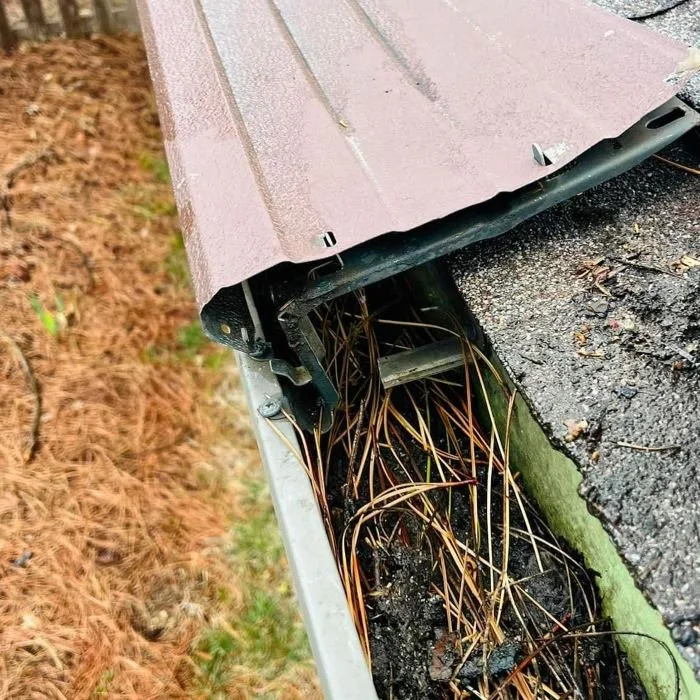Gutter Protection / Gutter Guard Options
LeafBlaster Pro
Our LeafBlaster Pro gutter guards are some of the best gutter protection on the market at a fraction of the national brand prices. These gutter guards are a stainless steel micromesh. The fine mesh screen keeps everything out of your gutters including pine needles and roof grit.
These guards keep the pitch of your roof, instead of laying flat, so that leaves, dirt, and debris will flow off the side. On a shingle roof, they are installed by sliding the back of the guard just slightly under your shingles. On a metal roof, these guards are bent on the back, using a metal brake, and screwed to the fascia so they won’t slide down.
LeafBlaster Pro is backed by a 40 year manufacturer’s warranty along side of our 3 year workmanship warranty on the installation of the product. When you sign up for the warranty, the manufacturer will send you a free metal wire brush for cleaning.
The ShurFlo Gutter Protection system is another popular choice amongst homeowners looking for a more budget friendly system, that still keeps leaves out. This system is made from aluminum and has small holes in the top, allowing for water to pass through without leaves and debris. The ShurFlo Gutter Protection system comes with a 20 year manufacturer’s warranty.
About Gutter Protection / Gutter Guards
Gutter protection, gutter guards, leaf guards, gutter screens, or whatever you may call them, are designed to prevent leaves and other debris from clogging up your gutter system. With all the options out on the market, it can be hard to decide which system is right for the situation at your home. To make matters worse, there are a lot of national brands making misleading claims about their abilities and what they can do for you.
Do gutter guards work?
The great news is YES! Gutter guards do work!
But first, lets talk about what they were designed to do. Gutter guards protect your gutter system, downspouts, and underground drainage from getting clogged up, which can cause a whole host of issues from rotting roof, fascia, and soffit, to damaging your home’s foundation.
Are gutter guards maintenance free?
Unfortunately, the answer to that question is NO.
All gutter guards, from the most expensive national brand to the cheapest guard you can find at your local home improvement store, need to be cleaned and maintained on a regular basis. How often you have to clean them will depend on your proximity to trees and what types you have on your property and in your area. If you live in the woods, you will have to clean off the tops of your gutter guards 3 or 4 times a year. If you only have a couple of trees nearby, you may only have to clean them off once or twice per year.
The most maintenance that will have to be done to gutter guards is on inside corners of your roof. Anywhere you have two roof lines coming together, it creates a “valley.” These valleys create a concentrated stream of water which can come down with such velocity (especially on a high pitch roof) that it jumps over your gutter system all together. In order to prevent water from doing this, “splash guards” are installed. This is a piece of aluminum, usually between 4 and 6 inches tall, that blocks the stream of water and allows the water to deflect back into your gutter system. Unfortunately, with gutter guards, this is a catch 22 situation. Splash guards are also leaf collectors. Leaves and debris will collect in these corners with or without gutter guards. It’s important to maintain the inside corners more regularly than the rest of your gutters.
“But the salesman from the national brand said I never had to touch my gutters again!”
Sadly, many of these brands will tell you whatever you want to hear in order to sell you their “magic” products. The truth of the matter is that leaves and debris will still land on top of the guards and eventually clog them up. Water will begin to pour over the side, into your foundation or onto your deck.
Why would I buy gutter guards if I still have to clean them?
When leaf litter fills your gutters, it will work its way into your downspouts, and eventually clogs up your underground drainage. Downspouts will have to be disassembled and reassembled to remove the debris and once the clog makes it underground, you have to hire a specialty “roto-router” type plumber who has to use a specialized machine to clean the drain lines. In addition, cleaning leaves off the top of your gutters with a leaf blower or wire brush is quicker and easier than filling garbage bags with “gutter soup” by hand.
Gutter protection reduces the number of times per year that gutters need to be cleaned. It will also greatly reduce the time it takes to clean them. However, they do not make your gutters maintenance free.
Which gutter guards work the best?
In order to figure out which gutter guard works the best for your specific situation, let’s start with which types of gutter guards you should not use:
Plastic: Guards made of any type of plastic material are a red flag. Plastic is a cheap material. It will bend and warp from exposure to the sun. Most gutter guards made from plastic come from home improvement stores. However, some of these products come from national brands who use fancy words to convince you it’s not plastic.
Gutter Sponges: These are giant sponges that are supposed to lay in your gutters. They fill up with debris and stop allowing water to penetrate very quickly. The sponges will get caked up with debris, mold, and mildew. Once that happens, water will begin spilling over the side of your gutters, rendering them useless. They are also some of the least environmentally friendly systems to dispose of.
Gutter Covers: Solid covers, rollover covers, helmets, etc all attempt to sell you on “surface tension.” The water is supposed to follow that surface tension and roll into the slit below the cover, allowing water, but not debris to get into the gutter system. Unfortunately, rain doesn’t work that way in practice. With many parts of WNC being considered a “Temporate Rain Forest,” water will roll off the roof, over the covers, and straight over the side of your house.
In addition, what does roll over into the gutter includes some water, some debris, and lot’s of wasps, hornets, and other flying stinging insects who love to build their nests inside. Eventually the debris will clog up your gutters, and when it does, there is no way to get that debris out. You will find yourself replacing your gutters much quicker than expected. Gutter cleaning companies cannot and will not remove covers and reinstall them.
Guards with holes that are too wide: If a screen type gutter guard’s holes are too wide, they will allow dirt and debris to get into your gutters. As a rule, if you have to take a gutter guard off and clean underneath, then the gutter guards are not doing their job. Gutter cleaning companies generally will not remove guards, clean them, and then reinstall them.
Now that you have a better understanding of which guards don’t work and why, lets discuss the types of guards that do work:
Flat guards with holes stamped in them: There are several different options when it comes to this type of gutter guard. Each major gutter material company makes their own version of this. The way these guards work is that they sit flat on the gutter, like a cafeteria tray. This prevents the water from flowing over the side of the gutter. It keeps the leaves from going into the gutter, while the holes allow the water to drain into the system.
Advantage - This type of guard is that it works well and is still cost efficient.
Disadvantage - This type of guard is that excessive pine needles can sometimes get trapped in the holes. The flat tray can also collect leaves more than a guard that keeps the pitch of the roof.
Cleaning - A leaf blower will make quick work of cleaning this type of gutter guard. If you don’t have trees towering directly over your house, the blow off will rarely need to be done.
Micromesh guards: Just like the hole punched guards, there are several companies that provide similar offerings when it comes to micromesh, and for good reason. Micromesh allows water to flow through the guards, while keeping even the smallest debris out.
Advantage - From pine needles to roof grit, these type of guards will not let anything other than water get into your gutter system. If you have a lot of pine trees around your house, or are deeper in the woods, these guards hold tough.
Disadvantage - This type of gutter guard generally costs more. Micromesh is made from higher quality materials and manufacturing is more expensive.
Cleaning - Most of the time you can blow these guards off with a leaf blower. If any of the micromesh gets clogged up, you can use a metal wire brush to sweep them off. This is more likely in the spring while trees are in bloom.
Fill out a Form
or

